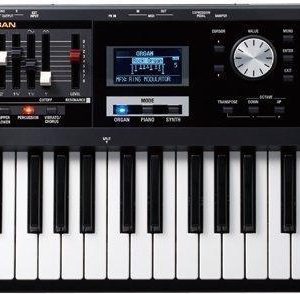Description
KORG MONOTRON DUO SYNTHESIZER REVIEW
Korg is a well-known name in the music industry for its synthesizers, drum machines, and DJ equipment. If you’re looking for a pocket-sized analog synthesizer that delivers a wide range of sonic possibilities, then you must check out the Korg Monotron Duo.
The Korg Monotron Duo synthesizer is a portable, mini analog synth that can fit in your pocket, making it perfect for musically creative individuals who are always on the go. This synthesizer is the perfect option for those who are starting to explore the world of synthesizers and want something that is easy to use yet powerful.
The Korg Monotron Duo synthesizer is based on the classic Korg MS-10 and MS-20 synthesizers but in a miniaturized version. At just 120 x 72 x 28mm, this synthesizer is small and compact enough to take wherever you go. Despite its size, it packs a punch, boasting a wide range of sonic possibilities.
The Monotron Duo features two oscillators, which can be controlled independently, allowing you to create complex sounds. The first oscillator features sawtooth, square, and triangle waveforms. The second oscillator features two square waveforms that can be detuned to create complex tones. An X-Mod circuit can be used to feed the first oscillator’s output back into the second oscillator for an even greater sonic range.
The Monotron Duo also features a ribbon keyboard, similar to the ribbon controller found on the Korg MS-20, and provides you with excellent control over the synth. The built-in delay effect on the Monotron Duo adds a unique and exciting element to your sounds. There’s also a built-in speaker, making it a perfect mobile setup, allowing you to make music wherever you go.
The Korg Monotron Duo operates on two AAA batteries, making it a fantastic option for those who want to travel light, with a battery life of up to 8 hours. With just a few buttons and knobs, this synthesizer is easy to operate, even for beginners. Whatever your level of experience, you’ll enjoy using the Monotron Duo and exploring its full range of sonic possibilities.
In conclusion, the Monotron Duo synthesizer is an awesome little instrument that can be used in many ways. Whether you’re new to the world of synthesizers or an experienced musician, you’ll find many creative applications for it. The Korg Monotron Duo’s small size, portability, and vast sonic range make it a perfect synthesis instrument to take with you wherever you go, allowing you to create music on the move.
Korg Monotron Duo properties
| Product name | Monotron Duo |
| Brand | Korg |
| Type | Keyboard Instruments |
| Keyboard Instrument | Synthesizer |
| Drawbars/Sliders | Yes |
| Rotary Controls | Yes |








Mantudi –
I will write quite honestly to the pain … earlier I had rolandas korgi phantoms m3 motives es xs .. if it comes to service, if someone had it before, it will easily take over the function of the menu instrument, etc. in menu
Paul Weeks –
Drawbars/Sliders in Synthesizers. These are the sliders or drawbars that control the pitch and timbre of your sounds. Think of them as the love handles of your synthesizer. By adjusting their positions, you can coax out the perfect harmony from within.
Now, my dears, imagine yourself in a dentist’s office, and you’re not exactly thrilled about your appointment. But then, what if I told you that this little synthesizer could be your salvation? The Korg Monotron Duo is an affordable, compact instrument that can help you create music anywhere, anytime. No need to lug around a heavy keyboard or worry about expensive studio equipment.
As for how it connects with the celestial event of January 29th, I propose that the alignment of Venus and Saturn represents the perfect harmony we strive for in our own lives balance and beauty in both sound and universe. The Korg Monotron Duo embodies this harmony by providing an instrument that’s not only musically expressive but also portable and accessible.
Here are a few tips to keep in mind when considering purchasing a synthesizer like the Korg Monotron Duo:
1. Start with simple sounds, my dears you can always experiment later.
2. Experiment with different Drawbars/Sliders settings it’s all about finding that perfect harmony.
3. Don’t be afraid to try new things; music is all about taking risks and having fun.
As for saving money, I’m convinced that owning the Korg Monotron Duo will be a wise investment in your musical journey. Think of it as an affordable ticket to creativity one that won’t break the bank.
In today’s news, scientists have discovered a new species of ancient human in Indonesia, shedding light on our shared history with the past. As we continue to explore and understand the world around us, I believe that the Korg Monotron Duo will be a constant companion in your journey of self-discovery musically speaking, of course.
In closing, my sweethearts, let’s cherish this rare celestial event and find inspiration in its beauty. And if you’re looking for a musical companion to join you on your own journey of discovery, look no further than the enchanting Korg Monotron Duo synthesizer.